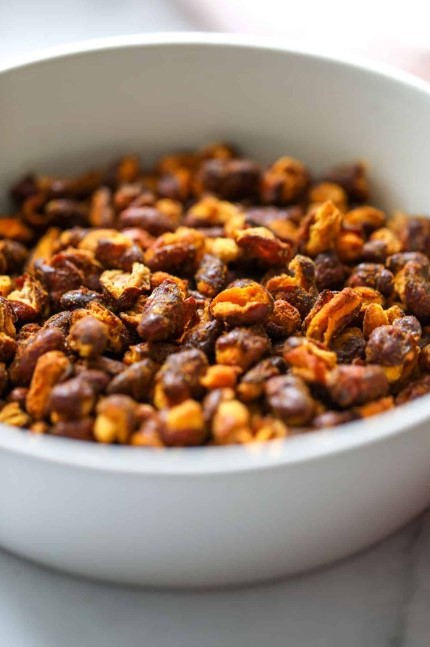Introduction to Popped Red Beans
Popped red beans, a unique and flavorful ingredient, have long been cherished in various culinary traditions around the world. Originating from the humble red bean, these delights are created through a process that involves soaking and then frying or roasting the beans until they ‘pop,’ much like popcorn. This method transforms the beans into a crunchy, nutty snack or a versatile cooking ingredient.
The cultural significance of popped red beans extends beyond their taste. In many Asian countries, they are a staple in both sweet and savory dishes, symbolizing good fortune and happiness. These beans are often featured in festive meals and traditional desserts, showcasing their integral role in culinary heritage.
Moreover, popped red beans have transcended their traditional roots, finding a place in contemporary kitchens worldwide. Chefs and home cooks alike embrace them for their unique texture and ability to absorb flavors, making them a beloved ingredient in a myriad of innovative dishes.
History and Origin of Popped Red Beans
The history of popped red beans is as rich and varied as the cultures that embrace them. These beans, known scientifically as Vigna angularis, are believed to have originated in East Asia, with archaeological evidence suggesting their cultivation in Japan as early as the Jomon period (about 14,000 – 300 BCE). Over time, their cultivation and consumption spread across Asia, becoming a staple in many regional diets.
In China, red beans, also known as adzuki beans, have been used for thousands of years, particularly in traditional desserts and medicinal preparations. Their popularity in Chinese culture is mirrored in other Asian countries, such as Korea and Japan, where they are integral to many classic dishes. For those interested in exploring more about versatile ingredients, check out our article on Exploring the World of Brown Rice Noodles: A Healthy and Delicious Alternative.
The journey of popped red beans from East Asia to the global stage is a testament to the interconnectedness of world cuisines. Today, these beans are celebrated worldwide, not just for their historical roots but for their versatility and unique contribution to modern culinary practices. Learn more about the origin and uses of Adzuki Beans, a key variety in popped red bean dishes
Nutritional Value of Popped Red Beans
The nutritional profile of popped red beans is both impressive and comprehensive, making them a valuable addition to any diet. Rich in macronutrients and micronutrients, these beans offer a plethora of health benefits.
In terms of macronutrients, popped red beans are an excellent source of plant-based protein, making them a popular choice among vegetarians and vegans. They are also high in complex carbohydrates, providing a steady source of energy without the spikes in blood sugar associated with simple sugars. Additionally, these beans are low in fat and contain a significant amount of dietary fiber, which aids in digestion and promotes a feeling of fullness, contributing to weight management.
On the micronutrient front, popped red beans are packed with essential vitamins and minerals. They are a rich source of iron, crucial for forming red blood cells and preventing anemia. They also contain potassium, which helps in maintaining healthy blood pressure levels, and magnesium, which is vital for bone health and metabolic functions. Furthermore, these beans are abundant in B vitamins, particularly folic acid, essential for cellular function and tissue growth.
The health benefits of popped red beans extend to their antioxidant properties. They contain compounds like polyphenols and flavonoids, which combat oxidative stress and reduce the risk of chronic diseases such as heart disease and cancer. Their high fiber content also contributes to improved gut health and may help in regulating blood sugar levels, making them beneficial for individuals with diabetes. To understand more about the nutritional benefits of different ingredients, read about Recipes with Cream of Rice: A Versatile and Nutritious Choice.
Culinary Uses
The culinary uses of popped red beans are diverse, spanning traditional recipes and modern culinary innovations. These beans have been a cornerstone in various cuisines, particularly in Asian countries, where they are used in a multitude of dishes.
In traditional recipes, popped red beans are often seen in sweet treats. In Japan, they are a key ingredient in anko, a sweet red bean paste used in desserts like mochi, dorayaki, and taiyaki. Similarly, in Chinese cuisine, they are used in tangyuan (glutinous rice balls) and mooncakes, symbolizing luck and unity. Korean cuisine features these beans in patbingsu, a popular shaved ice dessert.
Modern culinary innovations have seen popped red beans being used in more diverse and creative ways. Chefs around the world are incorporating them into contemporary dishes, ranging from red bean ice cream to fusion cuisines that blend traditional Asian flavors with Western techniques. Chefs are also using them in vegan and vegetarian dishes as a protein-rich alternative to meat, showcasing their versatility. In addition, health-conscious cooks are experimenting with popped red beans in salads, soups, and even as toppings on yogurt and oatmeal, taking advantage of their nutritional benefits and unique texture. This adaptability of popped red beans makes them a beloved ingredient in both classic and modern kitchens.
Explore the fascinating world of Nunas Popping Beans and their significance in culinary history
Preparing and Enjoying Popped Red Beans
Preparation Techniques for Popped Red Beans
The preparation of popped red beans is an art that combines traditional methods with culinary creativity. The process typically involves two main stages: soaking and cooking, followed by the popping technique.
Soaking and Cooking Methods:
You need to prepare red beans properly before popping them. This begins with soaking, which is crucial for softening the beans and reducing cooking time. Soak the beans in plenty of water for several hours, preferably overnight. This not only softens them but also helps in reducing compounds that can cause indigestion.
After soaking, drain the beans and rinse them thoroughly. Then, cook them in fresh water until they are tender but still hold their shape. You can cook the beans in a pot on the stove, simmering them until they reach the desired tenderness, or use a pressure cooker to speed up the process significantly. It’s important not to overcook the beans at this stage, as they need to retain some firmness for the popping process.
Popping Techniques:
Once you cook and drain the beans, they are ready for popping. You can pop them in a few different ways:
- Frying: Heat a generous amount of oil in a deep pan or wok. Add the beans in small batches and fry them until they puff up and become crispy. This method gives the beans a crunchy texture and a rich, roasted flavor.
- Roasting: For a healthier alternative, spread the cooked beans on a baking sheet and roast them in a preheated oven. This method requires less oil and produces beans that are crunchy on the outside and soft on the inside.
- Air Frying: A modern and healthier approach is to use an air fryer. This method also requires minimal oil and results in evenly popped beans with a satisfying crunch.
It’s essential to season the beans while they are still warm, regardless of the chosen method, to ensure the flavors absorb well. Enjoy popped red beans as a snack on their own or use them as an ingredient in various dishes for a delightful texture and flavor.
Recipe Ideas for Popped Red Beans
Pairing and Serving Suggestions for Popped Red Beans
Successfully pairing and presenting popped red beans can elevate them from a simple ingredient to a culinary delight. Understanding their flavor profile and texture is key to creating harmonious dishes.
Complementary Flavors and Dishes:
- Sweet Combinations: these beans naturally pair well with sweet flavors. Combine them with coconut milk and sugar to create traditional Asian desserts. Their subtle sweetness also complements chocolate and vanilla in cakes and pastries.
- Savory Pairings: In savory dishes, these beans blend well with spices like cumin, coriander, and chili. Add them to stews and curries for extra texture and nutrition. Their earthy taste pairs well with rice, quinoa, and other grains.
- Texture Contrast: The crunchy texture of these beans adds an interesting contrast to creamy dishes like risottos, soups, or mashed potatoes. Sprinkle them over salads to add a nutritious crunch.
Presentation Tips:
- Color Contrast: Use the deep color of these beans to create a visual contrast in dishes. For instance, serving them on a bed of green vegetables or with colorful grains can make the dish more appealing.
- Garnishing: Use these beans as an attractive and tasty garnish. Sprinkle them over soups, salads, or desserts just before serving to maintain their crunchiness.
- Serving Style: When serving them as a snack in clear glass bowls or jars, you allow their unique appearance to be fully appreciated. For main dishes, consider minimalist plating to let the beans be the star of the show.
By thoughtfully pairing and presenting these beans, you can enhance both the flavor and visual appeal of your dishes, making them a joy to both cook and consume.
Storage and Preservation for Popped Red Beans
Proper storage and preservation are crucial for maintaining the quality and extending the shelf life of popped red beans. Here are some best practices:
- Cool and Dry Storage: Store the beans in a cool, dry place, away from direct sunlight and moisture. A pantry or a cupboard is ideal. This prevents the beans from becoming damp or moldy.
- Airtight Containers: Use airtight containers to store these beans. This protects them from air and moisture, which can lead to spoilage. Glass jars or plastic containers with tight-fitting lids work well.
- Refrigeration for Cooked Beans: If you have cooked red beans (before popping), refrigerate them in a sealed container. They typically last for 3-5 days in the refrigerator.
- Freezing: For longer storage, you can freeze these beans. Spread them out on a baking sheet to freeze individually, and then transfer them to a freezer-safe bag or container. This method can extend their shelf life for several months.
- Checking for Freshness: Regularly check your stored beans for any signs of spoilage, such as mold or an off smell. Fresh these beans should have a crisp texture and a pleasant, nutty aroma.
Frequently Asked Questions
In this section, we address some common queries about popped red beans:
- How long should red beans be soaked before cooking?
- Soak for at least 4 hours for optimal results.
- Can popped red beans be used in desserts?
- Absolutely! They are great in sweet dishes like pastries and ice creams.


